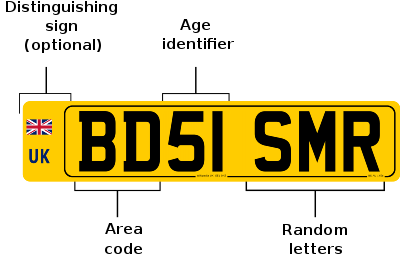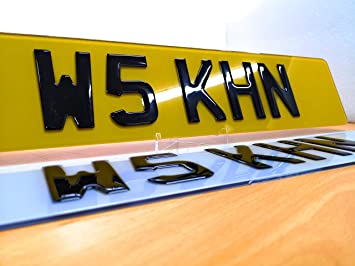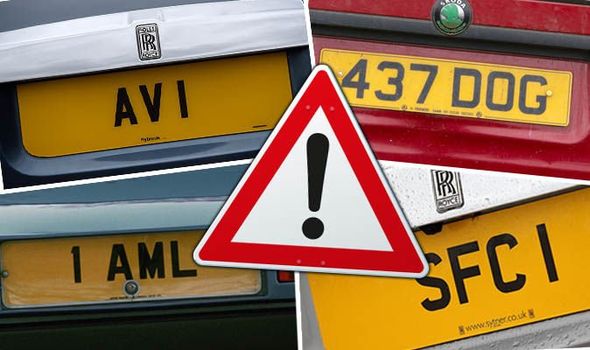Legal plate numbers are crucial to vehicle ownership, helping drivers keep track of their vehicle’s registration, prevent fraud and theft, and remain compliant with the law. Many rules and regulations surround legal number plates, which can confuse new and experienced drivers alike.
Whether you’re applying for a brand-new plate or looking to spruce up an old one, this comprehensive guide will help explain everything you need to know about legal number plates in the UK.
Decoding UK Number Plate Regulations
If you’re driving in the UK, there are specific regulations your number plate must adhere to. The DVLA (Driver and Vehicle Licensing Agency) is the governing body that sets out all of these rules that UK drivers must strictly follow. The DVLA ensures that number plates are standardised and legal across the UK, maintaining uniformity and adherence to essential guidelines.
A legal number plate number comprises three key components:

- DVLA Memory Tag: The DVLA memory tag is a two-letter code related to the area in which your vehicle was registered, such as ‘BA’ or ‘BY’ for Birmingham and ‘OA’ or ‘OY’ for Oxford.
- Age Identifier: This two-digit code lets you know the age of your car and when your vehicle was registered.
- Random Letters: The three random letters indicate your car’s unique identity, which the DVLA randomly assigns.
Let’s use ‘MA20 XCV’ as an example. The first two letters, MA, refer to the memory tag from the DVLA, with MA indicating that this car was registered in Manchester. The following two numbers (20) show the age of the vehicle and that the car was recorded between March 2020 to August 2020. Finally, XCV are three randomly assigned letters which act as a unique identifier for the vehicle.
Standard Number Plate Specifications
The DVLA has certain requirements that a driver must meet to have a legal number plate for their vehicle. Font, size, and spacing specifications for characters on a number plate are essential for legibility.
- Material: Number plates must be made from a reflective material.
- Font: Number plates must follow a specific font, called Charles Wright or ‘Block.’
- Size: Characters on number plates must be 79mm in height and 50mm in width, with a character stroke of 14mm wide. Additionally, the space between characters must be 11mm.
- Font Colour: Number plates must use black characters.
- Background Colour: The background of the front plate must be white, and the rear plate must be yellow. Patterns in the background are not allowed.
- British Standard Number: Vehicles fitted after 1 September 2021 must display ‘BS AU 145e.’ Those fitted before said date must show ‘BS AU 145d’ on the plate.
Moreover, the DVLA permits raised or 3D characters and specific flags, symbols, or identifiers. They also allow green flashes for zero-emission vehicles.

Personalised Number Plates: Rules and Possibilities
While standard number plates are essential, many drivers in the UK opt for private or personalised number plates to add a bit of flair and uniqueness to their cars. However, there are essential rules governing these types of number plates.
Eligibility Criteria
There are eligibility requirements to fulfil if you’re interested in a private or personalised number plate. These criteria ensure that personalised plates maintain the integrity of the DVLA system. Remember that while creativity is encouraged, there are exclusions and restrictions to prevent offensive or misleading content.
Should you choose a personalised plate, it must:
- Be in line with DVLA standards.
- Not contain any words or phrases that are deemed offensive or inappropriate.
- Not suggest a false association with the DVLA or any other government body.
- Have numbers and letters that are visible from miles away and not obscured in any way.
- Not mimic a registration plate used by diplomatic corps, police, or emergency services.
If you choose a private or personalised number plate, you can create your own combinations of numbers and letters. Alternatively, you can purchase an existing plate from the DVLA, a private dealer, or at a registration number auction.

Designing Personalised Plates Within Regulations
Personalised plates offer a unique chance to express yourself while staying within legal limits. You can exercise creativity while respecting font and size guidelines. To give you inspiration, numerous well-designed examples demonstrate how to personalise plates while adhering to the law.
There are also reputable number plate companies like Show Plates World that can design and create personalised plates for you. They help you to choose the right number plate, considering eligibility criteria, legal guidelines, and current trends.
Transfers and Retention
The legal number plate typically stays with the vehicle, even if you decide to transfer ownership. If you want to keep your registration number, the DVLA permits personalised number plate transfers and retention. These procedures allow you to transfer an existing plate to another car or store your current registration number for future use without transferring it to a new vehicle.
For these processes, you may need the following:
- A V750 Certificate of Entitlement
- A V778 retention document
- A V317 form
- A V5C logbook
Should you retain your registration number, you can request that it be held with the DVLA or transferred to another car up to 10 years after the original transfer. You may also transfer your personalised registration number to another person or relinquish your rights to it if you no longer need it.
Consequences of Non-Compliance
UK drivers must follow DVLA rules and regulations when designing, displaying, or transferring number plates. There are severe consequences for those who fail to comply with standards.
Automated Recognition Systems
Automated number plate recognition (ANPR) systems are crucial in enforcing number plate regulations. They monitor and identify non-compliant plates, triggering alerts that can lead to further actions. Thus, ensuring your plate’s compliance is essential to avoid unwanted consequences.
Legal Ramifications
Using illegal number plates comes with potential fines, penalties, and legal consequences. These repercussions extend beyond the initial monetary impact and can affect your vehicle registration, insurance coverage, and road safety. It’s a stark reminder of the significance of abiding by the law.
How To Maintain Legal Number Plates
Responsible UK drivers should check their number plates regularly to ensure compliance. Here are some tips for keeping your number plates legal.
Regular Maintenance
Regularly inspecting your number plates for wear and tear is a simple yet effective practice. Check for signs of fading or discolourations and indications of damage or deterioration.
Ensure the font is legible and all characters adhere to size guidelines. Maintaining clear and visible plates ensures you remain compliant with regulations and contribute to road safety for you and others.
Cleaning Tips
Keeping your number plates clean helps maintain clarity and visibility. Clean them gently with lukewarm water and a mild detergent solution. Avoid using abrasive cleaners or sharp objects to prevent damage. Wipe off any excess moisture to prevent mould or other issues.
Staying Informed
Number plate regulations might evolve over time. It’s essential to stay informed about any amendments or updates that could impact your plates’ legality. The DVLA and other reputable sources provide accurate information, helping you navigate any changes seamlessly.
How Number Plate Industry Professionals Can Help
The number plate industry is a complex field with various rules and regulations. Professionals in the industry can help you understand these complexities and make informed decisions that meet your needs while staying within legal limits. With experts, you’ll have peace of mind when navigating regulations for standard and personalised plates.
Ensuring Compliance and Customization
Number plate companies like Show Plates World possess expertise in crafting plates that meet legal criteria and showcase your style. These professionals ensure that your personalised plates are compliant while providing you with options for customization within the regulations.
Another advantage of ordering a personalised number plate from the experts is that they can help you decide the best combination of letters and numbers. They will handle all the paperwork for you, ensuring accuracy in applications and helping you avoid any legal issues. Turnaround times tend to be much quicker as well compared to government institutions.
Finding the right professionals to work with is critical, as it guarantees you’ll get quality service and reliable advice. Asking for recommendations from trusted sources can help you make an informed decision when selecting a number plate provider.
Conclusion
There’s much to consider when it comes to vehicle ownership and legal number plates. As a UK driver, you must be mindful of the rules and regulations to remain compliant with the DVLA. Your compliance contributes to road safety, protecting you and others from vehicular hazards and legal ramifications.
By partnering with trustworthy number plate companies like Show Plates World, you can enjoy personalised plates that align with UK standards while avoiding the consequences of non-compliance. Remember, a legal number plate isn’t just a legal requirement — it’s a statement of your responsible and considerate approach to driving in the UK.
For more information on legal number plates, visit Show Plates World to try our number plate maker. Contact us today for a smooth and hassle-free number plate experience.

